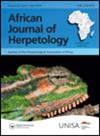秋春季极度濒危几何陆龟日常活动、活动和避难所的变化
IF 0.9
4区 生物学
Q3 ZOOLOGY
引用次数: 6
摘要
摘要/ Abstract摘要:为评价濒危几何象龟的生境需求,采用线迹法对2002年秋春两季几何象龟成虫的日常活动、迁移和避难情况进行了研究。我们发现季节、天气、个人和性别的影响存在很大差异。高活度与秋季和春季气候温和一致。然而,每天的温度限制了女性在凉爽的秋天的活动和男性在温暖的春天的活动,这种模式与性别大小二态性(雌性大,雄性小)一致。秋天的长时间迁徙可能有助于陆龟找到秋雨后生长迅速的食用植物;两性从秋天的低谷中恢复身体状态,雌性在深秋和冬季开始产卵。这些动作也可以帮助雄性在排卵前与雌性交配。雌性在春季的高活动有助于它们觅食,维持它们在春季的卵黄形成、产卵和筑巢。在这两个季节,男性的路径往往比女性的路径更线性,所以这种性别差异可能与食物消耗无关。雄性可能会走很长的线性路线来吸引雌性并避开其他雄性。雄性在春天可能会受到热挑战。它们的活动随着地面温度(在阳光下)的升高而减少,春季比秋季使用更密集的避难所,春季比雌性使用更密集的避难所。几何龟通常在连续的夜晚使用不同的避难所,这是一种躲避捕食者的机制。本文章由计算机程序翻译,如有差异,请以英文原文为准。
Variation in the daily activity, movement and refugia of Critically Endangered geometric tortoises, Psammobates geometricus, in autumn and spring
Abstract To help assess habitat requirements of Critically Endangered geometric tortoises, we used thread-trailing to measure daily activity, movements and refugia of adult Psammobates geometricus in autumn and spring 2002. We found strong differences between seasons, and effects of weather, individuals and sex. The high activity was consistent with mild weather during autumn and spring. However, daily temperatures limited female movements on cool autumn days and male movements on warm spring days, a pattern consistent with sexual size dimorphism (large females and small males). The long movements in autumn probably helped tortoises find food plants that grow quickly after autumn rains; both sexes recover body condition from autumn lows, and females begin egg production in late-autumn and winter. These movements may also help males mate with females before they ovulate. The high activity of females in spring should help them forage and sustain their vitellogenesis, egg production and nesting in spring. Male paths tended to be more linear than female paths in both seasons, so this sexual difference is likely not linked to food consumption. Males may move long, linear paths to engage females and avoid other males. Males may have been thermally-challenged in spring. Their movements decreased with increased ground temperatures (in the sun), they used denser refugia in spring than in autumn, and in spring used denser refugia than females used. Geometric tortoises typically used different refugia on consecutive nights, a type of predator avoidance mechanism.
求助全文
通过发布文献求助,成功后即可免费获取论文全文。
去求助
来源期刊

African Journal of Herpetology
ZOOLOGY-
CiteScore
3.00
自引率
6.70%
发文量
15
审稿时长
>12 weeks
期刊介绍:
African Journal of Herpetology (AJH) serves as an outlet for original research on the biology of African amphibians and reptiles. AJH is an interdisciplinary journal that publishes original articles and reviews from diverse fields and disciplines, such as conservation, phylogenetics, evolution, systematics, performance, physiology, ecology, behavioural ecology, ethology, and morphology.
The Journal publishes two issues a year. There are no page charges .
 求助内容:
求助内容: 应助结果提醒方式:
应助结果提醒方式:


